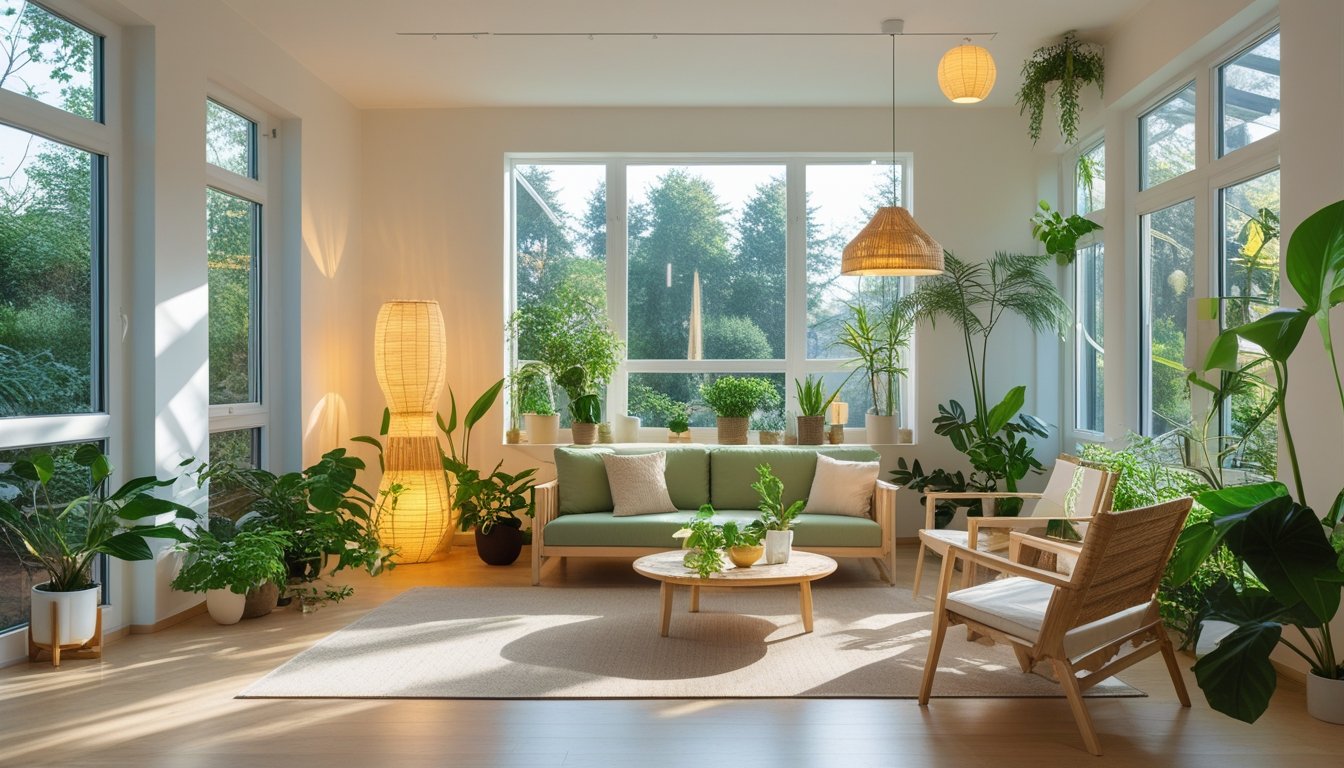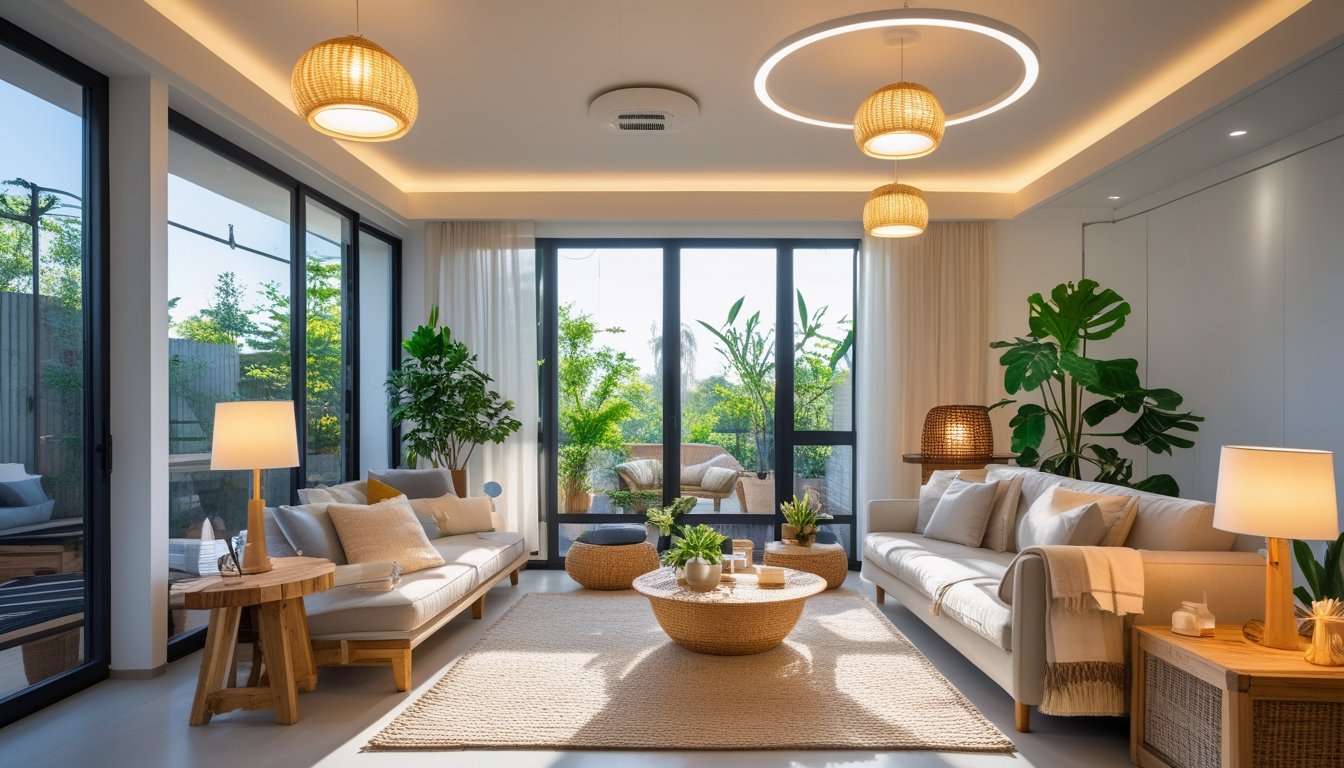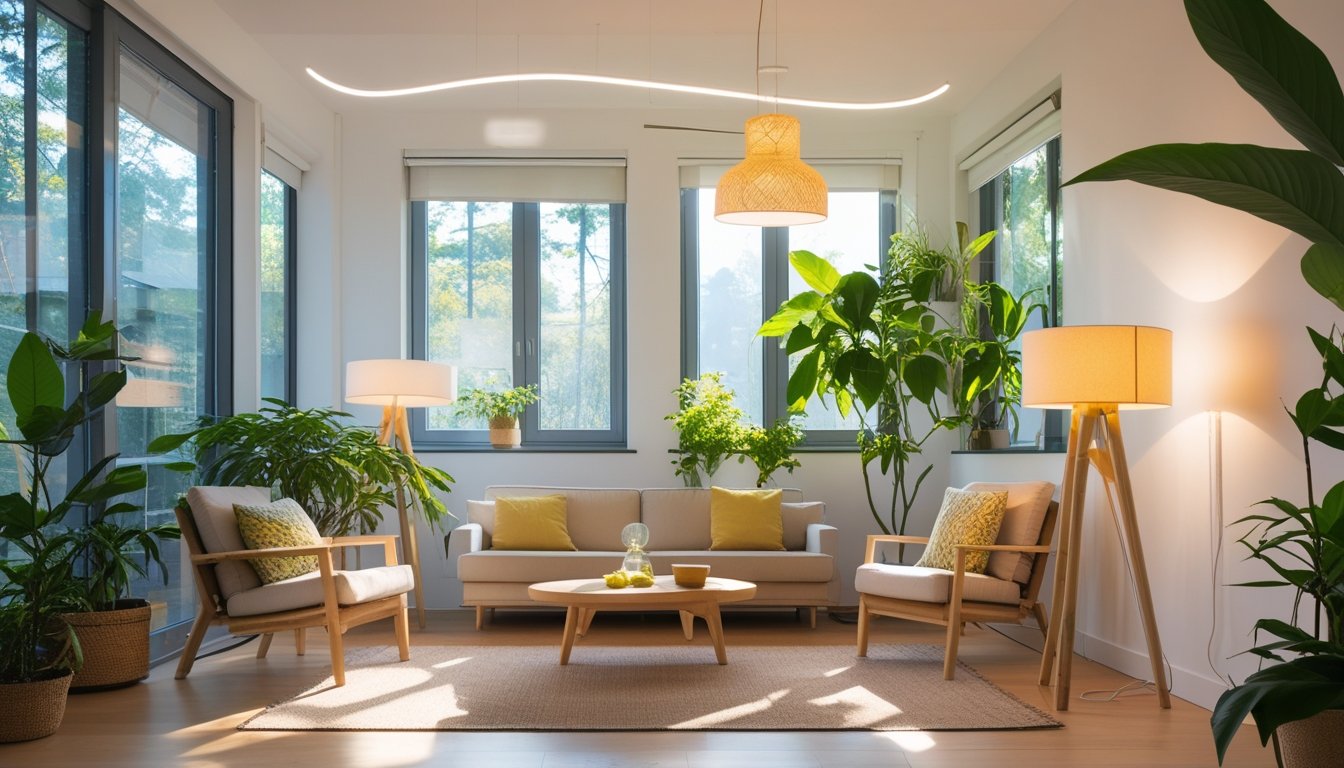Late updated: 06 Oct 2025 10:10
Written by: Sarah Hollister
Eco-Friendly Lighting Ideas For Your Home: Brighten Up Sustainably
Transforming our homes with eco-friendly lighting is not only a sustainable choice but also an inviting way to enhance the ambiance. By switching to energy-efficient lighting options, we've discovered ways to significantly reduce our carbon footprint while maintaining a stylish environment. LED lights, known for their low energy use and long lifespan, offer a dual benefit of reducing both electricity costs and the need for frequent replacements.

Let's delve into practical design ideas that can help us embrace sustainability without compromising on style. Incorporating elements such as dimmers and solar lamps can further optimise energy usage and adapt to different moods and settings. By layering lighting and selecting materials derived from nature, we contribute to a healthier and more eco-conscious living space.
Key Takeaways
- Sustainable lighting options reduce electricity consumption.
- Integrating design elements can enhance eco-friendliness and style.
- LED lights offer long-term benefits and cost savings.
Essential Eco-Friendly Lighting Solutions
Implementing eco-friendly lighting solutions in our homes can dramatically reduce energy consumption and lower greenhouse gas emissions. By selecting energy-efficient and sustainable lighting options, we also enjoy the dual benefits of long-term savings and a reduced carbon footprint.
Energy-Efficient Bulbs: LED and Compact Fluorescent Lamps
LED and Compact Fluorescent Lamps (CFLs) are two of the most effective energy-saving bulbs available. LED bulbs are known for their long lifespan and excellent energy efficiency, using up to 75% less electricity compared to traditional incandescent bulbs. They also produce minimal heat, further conserving energy.
CFLs offer similar benefits, being slightly less efficient than LEDs but more affordable. These bulbs last much longer than traditional bulbs and provide considerable savings over time. Additionally, both options are available in a range of colours and brightness levels, making them versatile choices for various lighting needs.
Solar-Powered Lighting Options for Indoors and Outdoors
Solar-powered lights are an innovative solution for reducing electricity usage. They harness sunlight during the day to power lights at night, making them ideal for both indoor and outdoor applications.
Exterior solar lights are perfect for gardens or pathways, requiring no wired connections, thus allowing flexibility in placement. Indoors, solar-powered desk lamps or lanterns can provide sustainable lighting solutions. Using solar-powered options decreases reliance on grid power, significantly cutting down energy costs and enhancing sustainability.
Maximise Natural Light with Skylights and Solar Tubes
Maximising natural light is another strategy to promote eco-friendly lighting. Skylights and solar tubes effectively channel sunlight into our homes, reducing the need for artificial lighting during the day. Skylights can be installed on roofs to provide ample daylight in larger spaces.
Solar tubes are compact and inexpensive, capturing sunlight through a small dome and directing it indoors via reflective tubes. This method is ideal for areas lacking space for skylights. Both solutions contribute to reducing energy consumption and improve indoor ambiance with natural illumination.
Smart Lighting Systems for Enhanced Efficiency
Smart lighting systems offer us the opportunity to control lighting usage precisely, further improving energy efficiency. These systems employ technology such as motion sensors, timers, and remote control via smartphone apps to optimise lighting based on our needs.
Motion sensor lights automatically switch off when no movement is detected, preventing unnecessary energy use. Smart lighting systems also allow us to adjust brightness and set schedules, ensuring lights are used only when necessary. By integrating these systems, we can reduce energy consumption, thus contributing to a smaller carbon footprint and lower electricity bills.
Practical Design Ideas for a Sustainable Home

Creating a sustainable home requires careful consideration of lighting design and material choices. By incorporating dimmers, eco-friendly fixtures, and innovative LED technology, we can significantly reduce energy consumption while maintaining a comfortable ambiance.
Incorporating Dimmers and Adaptive Lighting Design
Dimmers offer a simple yet effective way to control the intensity of light in our homes. By adjusting the brightness to match activities and mood, we not only enhance comfort but also save energy. Adaptive lighting design helps by using sensors to adjust light levels based on natural light availability or occupancy. This not only conserves energy but also extends the lifespan of our lights. The combination of dimmers and adaptive systems creates a dynamic and customisable environment, ensuring optimal lighting throughout the day and night.
Eco-Friendly Light Fixtures and Upcycled Materials
Choosing eco-friendly fixtures made from sustainable or upcycled materials helps minimise our environmental impact. Fixtures crafted from recycled metals, glass, or sustainable woods offer both durability and aesthetics. Upcycled materials give a unique character to designs and often tell a story of transformation. When selecting light fixtures, it's crucial to consider their lifecycle and environmental footprint. Opting for those with replaceable parts ensures longevity, making our sustainable choice even more effective.
Creative Use of LED Strip Lighting
LED strip lighting provides versatility and energy efficiency, fitting seamlessly into various home designs. These lights offer low heat emission and a long lifespan, making them suitable for both accent and task lighting. By placing them under cabinets, along staircases, or within shelving units, we can highlight architectural features and create a modern look. Their flexibility in colour and intensity means we can easily adapt them to fit any space or mood. This makes LED strips an excellent choice for those looking to add a creative yet sustainable touch to their homes.
Transitioning from Traditional to Sustainable Lighting
Switching from traditional incandescent bulbs to sustainable lighting solutions like LEDs or CFLs can lead to significant energy savings. Traditional bulbs consume more energy and have a shorter lifespan compared to their modern counterparts. By transitioning, we benefit from reduced electricity bills and lower carbon emissions. This change can be implemented gradually, starting with high-use areas such as kitchens and living rooms. As we replace bulbs, we notice improved light quality and efficiency, reinforcing the importance of sustainable choices in our daily lives.
Frequently Asked Questions

Incorporating eco-friendly lighting options into our homes can significantly reduce energy consumption and environmental impact. By choosing the right products and designs, we enhance both efficiency and sustainability.
What are the most energy-efficient lighting options for a household?
LED bulbs are among the top energy-efficient choices, using significantly less energy than traditional incandescent bulbs. Compact Fluorescent Lamps (CFLs) are another good option, offering respectable efficiency and longevity.
How can smart lighting systems contribute to home energy savings?
Smart lighting allows us to control our lights remotely, schedule them to turn off when not needed, and adjust brightness based on natural light availability. This not only saves energy but also lowers electricity bills.
What are the environmental benefits of switching to LED lighting?
LED lighting consumes up to 85% less energy and lasts significantly longer than incandescent bulbs. This reduces greenhouse gas emissions and lessens the need for frequent replacements, resulting in less waste.
Can you suggest ways to optimise natural light in a home to reduce energy use?
We can enhance natural lighting by using large windows, skylights, and light-colored walls to reflect light. Well-placed mirrors can also increase light distribution in darker areas, reducing the need for artificial lighting during the day.
What should be considered when selecting eco-friendly light bulbs for various rooms?
Consider the room's function and lighting needs. For reading areas, choose bulbs with higher lumens for better brightness. In living spaces, warmer tones create a cosy atmosphere. Always check for the energy rating and longevity of the bulbs.
How does the installation of solar-powered lights affect a home’s energy consumption?
Solar-powered lights harness energy from the sun, reducing reliance on the grid. They're especially effective for outdoor lighting, such as garden paths and driveways, offering a sustainable way to illuminate outdoor spaces without increasing electricity usage.
